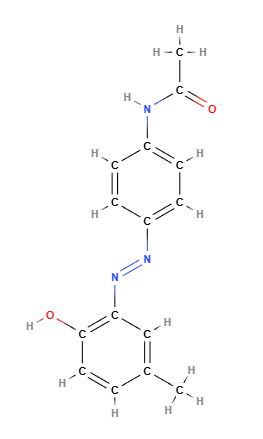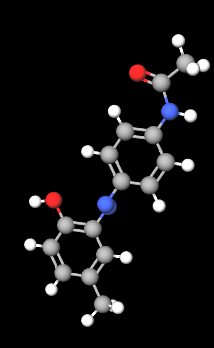Check the ingredients!
... live healthy!


| "Descrizione" by admin (19362 pt) | 2024-Oct-06 10:43 |
Solvent Yellow 77, also known as Disperse Yellow 3, is a synthetic azo dye with the chemical formula C15H15N3O2. It is primarily used in industrial applications for coloring plastics, textiles, and synthetic products. Due to its toxicological properties, this dye is classified in Category 2 for carcinogenicity by the European Union, meaning it is suspected of being carcinogenic to humans. As a result, its use in many applications, especially consumer products like textiles and cosmetics, has been severely restricted.
Chemical Composition and Structure
Solvent Yellow 77 is an azo dye composed of an azo bond (-N=N-) linking two aromatic rings, with amino and oxygen functional groups in its structure. Its chemical formula is C15H15N3O2, and its structure includes groups that can degrade into aromatic amines, which are known carcinogens. This characteristic raises significant concerns about its safety for human health and the environment.
Physical Properties
Solvent Yellow 77 appears as a yellow to orange crystalline powder, insoluble in water but soluble in organic solvents such as oils, waxes, and industrial solvents. It has good thermal and light stability, making it suitable for applications that require resistance to harsh environmental conditions, such as in synthetic materials and textiles.
Production Process
It is produced through an azo coupling reaction, where aromatic compounds are diazotized and then coupled to form the azo bond that gives rise to its characteristic yellow-orange color. The production process requires careful control to prevent the release of toxic aromatic amines during synthesis and product handling.
Applications
Textile Industry: Solvent Yellow 77 is used to dye synthetic textiles such as polyester and nylon due to its strong adhesion to synthetic fibers.
Plastic and Polymer Coloring: It is used to color plastics, appreciated for its chemical stability and light resistance, particularly in materials used outdoors.
Inks and Coatings: The dye is also used in certain industrial inks and coatings, where a bright and durable color is required.
Health and Safety Concerns
Carcinogenicity
Solvent Yellow 77 is classified in Category 2 for carcinogenicity by the European Union, meaning there is strong suspicion that it may cause cancer in humans. The primary concern is its potential degradation into aromatic amines, which are recognized for their ability to cause cancer, particularly bladder cancer. While there is no direct evidence linking Solvent Yellow 77 to human cancer, its chemical structure and the risk of releasing aromatic amines are enough to classify it as a potentially hazardous substance.

Toxicity
In addition to its carcinogenic potential, Solvent Yellow 77 can cause acute toxicity if ingested, inhaled, or absorbed through the skin. Prolonged exposure may result in skin and respiratory irritation. Given its classification and the potential for degradation into toxic compounds, it requires careful use in industrial settings, where worker protection measures are essential to minimize exposure.
Environmental and Safety Considerations
Solvent Yellow 77 is not biodegradable and can accumulate in the environment, particularly in aquatic ecosystems. Its toxicity and ability to degrade into aromatic amines pose a serious threat to environmental health. Its production and use require strict waste management procedures to avoid environmental contamination. Industries using this dye must adhere to stringent environmental regulations to ensure safety and minimize its environmental impact.
Regulatory Status
Due to its classification as a suspected carcinogen, Solvent Yellow 77 is heavily regulated in the European Union and other countries. Its use in consumer products such as textiles and cosmetics is limited or banned in many jurisdictions. In industrial settings, where it is used to color plastics and polymers, its use is subject to strict safety and disposal guidelines.
Applications Under Strict Control
Manufacturing: Despite the carcinogenic risk, Solvent Yellow 77 continues to be used in certain industrial applications, primarily for coloring plastics and synthetic textiles.
Research and Analytical Use: In some research contexts, the dye may be used under controlled conditions, where strict safety protocols are implemented.
Safety
The problem with azo dyes (monoazo or diazo) is photocatalytic degradation leading to oxidation and the subsequent formation of impurities such as aromatic amines, some of which have carcinogenic activity. (Chung KT, Stevens SE Jr, Cerniglia CE. The reduction of azo dyes by the intestinal microflora. Crit Rev Microbiol. 1992;18(3):175-90. doi: 10.3109/10408419209114557. )
The study cited in Bibliography finds that Overall, Solvent Yellow 77 exhibited carcinogenicity and genotoxicity and elicited haematological effects in experimental animals. It induced gene mutations in vitro in both bacteria and mammalian cells with and without metabolic activation. Solvent Yellow 77 caused DNA damages in vivo and in vitro. Solvent Yellow 77 induced liver nodules/tumours in female mice and male rats. It also induced hemosiderosis, likely via the N-hydroxylation of its aryl amine metabolites.
 |  |
Molecular Formula C15H15N3O2
Molecular Weight 269.30 g/mol
CAS 2832-40-8
UNII 0890872E2E
EC Number 220-600-8
CHEMBL1590721
DTXSID6021450
Synonyms:
Disperse yellow G
Solvent Yellow 77
Disperse yellow 3
References__________________________________________________________________________
Screening Assessment Aromatic Azo and Benzidine-based Substance GroupingCertain Azo Solvent Dyes. Environment and Climate Change Canada Health Canada May 2016
Synopsis. Pursuant to sections 68 or 74 of the Canadian Environmental Protection Act, 1999 (CEPA 1999), the Ministers of the Environment and of Health have conducted a screening assessment on 22 Azo Solvent Dyes. These substances constitute a subgroup of the Aromatic Azo and Benzidine-based Substance Grouping being assessed as part of the Groupings Initiative of Canada’s Chemicals Management Plan (CMP) based on structural similarity and applications. Substances in this grouping were identified as priorities for assessment as they met the categorization criteria under subsection 73(1) of CEPA 1999 and/or were considered as a priority based on other human health concerns. The Chemical Abstracts Service Registry Number (CAS RN)1, Domestic Substances List (DSL) name, and Colour Index (C.I) name or common name of the 22 substances are presented in the following table.....
| Evaluate |